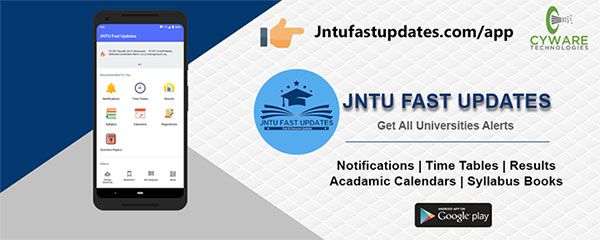JNTUK R20 3-1 Machining, Machine Tools & Metrology Material PDF Download
Students those who are studying JNTUK R20 Mechanical Branch, Can Download Unit wise R20 3-1 Machining, Machine Tools & Metrology (MMT&M) Material/Notes PDFs below.

JNTUK R20 3-1 Machining, Machine Tools & Metrology Material PDF Download
OBJECTIVES:
- The course provides students with fundamental knowledge and principles in material removal processes.
- In this course, the students apply the fundamentals and principles of metal cutting to practical applications through multiple labs using lathes, milling machines, grinding machines, and drill presses, Computer Numerical Control etc
- To demonstrate the fundamentals of machining processes and machine tools.
- To develop knowledge and importance of metal cutting parameters.
- To develop fundamental knowledge on tool materials, cutting fluids and tool wear mechanisms.
- To apply knowledge of basic mathematics to calculate the machining parameters for different machining processes.
UNIT-1
FUNDAMENTAL OF MACHINING: Elementary treatment of metal cutting theory – element of cutting process – Single point cutting tools, nomenclature of single point cutting tool, tool signature, tool angles, mechanism of metal cutting, types of chips and chip formation – built up edge and its effects, chip breakers, mechanics of orthogonal and oblique cutting –Merchant’s force diagram, cutting forces, velocity ratio, cutting speeds, feed, depth of cut, tool life, Taylor’s tool life equation, simple problems – Tool wear, tool wear mechanisms, heat generation in metal cutting, coolants, machinability, economics of machining, tool materials and properties.
UNIT-2
LATHE MACHINES: Introduction- types of lathe – Engine lathe – principle of working – construction – specification of lathe – work holders and tool holders – accessories and attachments – lathe operations – taper turning methods and thread cutting – drilling on lathes – cutting speed and feed-depth of cut.
SHAPING, SLOTTING AND PLANNING MACHINES: Introduction – principle of working – principle parts – specifications – operations performed – slider crank mechanism – machining time calculations.
UNIT-3
DRILLING & BORING MACHINES: Introduction – construction of drilling machines – types of drilling machines – principles of working – specifications- types of drills – geometry of twist drill – operations performed –cutting speed and feed – machining time calculations – Boring Machines – fine Boring Machines – jig boring machines – deep hole Drilling Machines.
MILLING MACHINES: Introduction – principle of working – specifications – milling methods – classification of Milling Machines –types of cutters – geometry of milling cutters – methods of indexing, accessories to milling machines – cutting speed and feed – machining time calculations
UNIT-4
FINISHING PROCESSES: Introduction – theory of grinding – classification of grinding machines- cylindrical and surface grinding machines- tool and cutter grinding machines- different types of abrasives- bonds, specification and selection of a grinding wheel-lapping, Honing & Broaching operations- comparison to grinding.
SYSTEMS OF LIMITS AND FITS: Introduction, nominal size, tolerance, limits, deviations, different types of fits -Unilateral and bilateral tolerance system, hole and shaft basis systemsinterchangeability, deterministic & statistical tolerances, selective assembly- International standard system of tolerances, selection of limits and tolerances for correct functioning, simple problems related to limits and fits, Taylor’s principle – design of go and no go gauges; plug, ring, snap, gap, taper, profile and position gauges – inspection of gauges.
UNIT-5
SURFACE ROUGHNESS MEASUREMENT: Differences between surface roughness and surface waviness –Numerical assessment of surface finish-CLA, Rt., R.M.S. Rz, R10 values, simple problems – method of measurement of surface finish – Profilograph, Talysurf, ISI symbols for indication of surface finish.
OPTICAL MEASURING INSTRUMENTS: Tools maker’s microscope, Autocollimators, Optical projector, Optical flats-working principle, construction, merits, demerits and their uses. optical comparators.
TEXT BOOKS:
- Manufacturing Processes / JP Kaushish/ PHI Publishers-2 nd Edition
- Manufacturing Technology Vol-II/P.N Rao/Tata McGraw Hill
- Engineering Metrology – R.K. Jain/Khanna Publishers
REFERENCE BOOKS:
- Metal cutting and machine tools /Geoffrey Boothroyd, Winston A.Knight/ Taylor & Francis
- Production Technology / H.M.T. Hand Book (Hindustan Machine Tools).
- Production Engineering/K.C Jain & A.K Chitaley/PHI Publishers
- Technology of machine tools/S.F.Krar, A.R. Gill, Peter SMID/ TMH
- Manufacturing Processes for Engineering Materials-Kalpak Jian S & Steven R Schmid/Pearson Publications 5 th Edition
OUTCOMES:
- CO1: Discuss the concepts of machining processes.
- CO2: Apply the principles of lathe, shaping, slotting and planning machines.
- CO3: Apply the principles of drilling, milling and boring processes.
- CO4: Analyze the concepts of finishing processes and the system of limits and fits.
- CO5: Learn the concepts of surface roughness and optical measuring instruments.

320-x100(1).gif)
